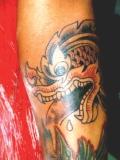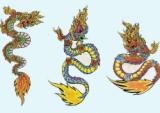Archives
TATTOOING TRADITIONS : REVIVING TRIBAL TATOO ART OF NORTHEAST
In first week of December when Mo Naga, India’s pioneering tattoo artist, was approached by a British couple James Paul Smith and Hannah as his first client, who came all the way from Landon to Assam, and incidentally heard about Mo’s new studio and tattoo school “Headhunters’ Ink” in Guwahati to promote indigenous Tattoo work of north-eastern tribes – he was a bit surprised. The couple was eager to get an imprint of the region’s unique tribal tattoo art on their body, after learning about his studio through the media.
The keenness of the foreign couple to make north-eastern tribal tattoo a lifetime memory made Mo, to give a serious thought about his research materials and collections he had with him so far. And, finally he made up his mind to depict the tale of Khoingaanlu on their arms. Indeed, the couple from London found it fascinating to share with their friends back in their home town.
“I was a bit suspicious about precipitations of my singular decision to open the studio and tattoo school in Guwahati to promote indigenous tattoo culture, prevalent among various tribes of north-east region. I am overwhelmed by the response and immense support which diversified section of people and media has given me. And the British tourist couple that I got as my first client has just added another mileage to my satisfaction”, says Mo, a young Manipuri with a zeal to do different and prove different.
 A self taught artist, and a qualified Fashion Designer from National Institute of Fashion Technology(NIFT)- Hyderabad, Mo’s professional life has been quite a successful one so far. His commercial opening “Mo tattoo” studio, located in New Delhi’s elite place Hauz Khas has been running well since 2008. He also became the local brand ambassador for Lee Jeans (V.F Corporation), for the Delhi and National Capital Region since 2008 till July 2010. Lee Jeans also promoted him as India’s Best Tattoo Artist in their campaign to give his passion, another dimension.
A self taught artist, and a qualified Fashion Designer from National Institute of Fashion Technology(NIFT)- Hyderabad, Mo’s professional life has been quite a successful one so far. His commercial opening “Mo tattoo” studio, located in New Delhi’s elite place Hauz Khas has been running well since 2008. He also became the local brand ambassador for Lee Jeans (V.F Corporation), for the Delhi and National Capital Region since 2008 till July 2010. Lee Jeans also promoted him as India’s Best Tattoo Artist in their campaign to give his passion, another dimension.
Researched and rated amongst the top three Tattoo Studios of India by Hindustan Times, New Delhi Edition, Mo Tattoos was invited to be a part of India’s biggest Tattoo Convention Tattoo Republic held in Pune, Maharashtra in November, 2011. This was an opportunity for Mo Naga to showcase his tattooing expertise amongst many world renowned and internationally acclaimed tattoo artists. Now he has a unique clientele that ranges people Brazil, USA, Germany, Netherlands, Spain, Russia, France, and Nigeria apart from the home country.
However, there was more to meet his desire to do something for the region he belongs, and fortunately which is bestowed with so much of vivid designs of indigenous tattoos, that are almost dying, mostly unexplored by a passionate expert like him and still virgin in terms showcasing these to world public!
“So, I realized this is the right time to come back to my region, make an extensive study and do wider research work of our traditional tattoos that have deep roots in traditions and customs and finally bring them out to wider audience” says an enthusiastic Mo, whose real name is Moranngam Khaling.
Till recently, tattoo has been considered a taboo. But today, it is considered as one of the fastest growing fashion industries in the country. The craze is more in most of the metros in India and there are more than 300 tattoo artists alone in Delhi, Mo adds. And, it is essential to understand basics of traditional tattoo art form of North East right now, so that it does not get spoiled by incorrect hands, he feels.Mo’s research and collections are so far based on books and internet resources, but soon he is planning to make visits to those tribes and communities among which the practice was there. Documentation of this traditional practice after field visits is the only way of showcasing it before the global audience, he feels.
The Nagas for instance, he says, has the custom of depicting tattoo which is deeply attached to their head-hunting system that was prevalent in the past. A person carrying a head of his enemy in the war was entitled to depict certain tattoo on his face, which gave his high regard in the society. The body art among some of the Naga tribes was done in such a fierce way so that it made his enemy frightened at one sight. However, with the elimination of head-hunting practice the tattoo art associated with it also faded and declined. Now, such tattoos can be seen only on elderly persons of these tribes in the age-group of 70-80.
 While tattoo practice among the Nagas says about the head-hunting practices of these warrior communities, among the Apatanis living in Arunachal Pradesh which is numbered as some 26,000, tattooing or Tiipe and the stuffing of large nose plugs or yaping hullo were done among the females to make them unattractive to males from neighboring tribes, so that they do not kidnap them. Apatani women were considered to be the most beautiful ones among all the Arunachali tribes. Among the traditional Wancho tribe, a man is tattooed on his limbs and his entire face, with the exception of certain regions around the eyes and the lips. Tattoo practice was done only among the married women of the Singpho tribe living in Uppermost Assam and Arunachal Pradesh. Both legs of these women from the ankle to the knee were tattooed, while the men tattooed their limbs.
While tattoo practice among the Nagas says about the head-hunting practices of these warrior communities, among the Apatanis living in Arunachal Pradesh which is numbered as some 26,000, tattooing or Tiipe and the stuffing of large nose plugs or yaping hullo were done among the females to make them unattractive to males from neighboring tribes, so that they do not kidnap them. Apatani women were considered to be the most beautiful ones among all the Arunachali tribes. Among the traditional Wancho tribe, a man is tattooed on his limbs and his entire face, with the exception of certain regions around the eyes and the lips. Tattoo practice was done only among the married women of the Singpho tribe living in Uppermost Assam and Arunachal Pradesh. Both legs of these women from the ankle to the knee were tattooed, while the men tattooed their limbs.
Tales and legends, traditions and customs, accompanied with these tribes and communities have actually made the terrain of India a land of natural ink. The richness of designs of tattoo culture has always been attracted Anthropologists and academics of other disciplines. Unfortunately, the practice has been stopped totally with modernity and now tattoo is seen only among the elderly persons of these communities.
“This is why study and revival of this art has become extremely important, to prove its sustenance in modern concepts of tattoo art by transforming them as real professional work. While promoting traditional Tatoo designs I am also simultaneously keen to bring traditional motifs and designs of other cultural components including dress, music and others, still unexplored, into this fashion-trend,” he says.
Tattoo art of north-eastern tribes have its own distinctiveness. They are large, dominant over the body, and present basic tribal art- unlike most of the tattoo practices among the tribes and communities in other parts of India which are small and not so dominant over the body.
To share his experiences and show integration with the local artists in Guwahati Mo also arranged a discussion with them recently, so that safe, hygienic and international standard tattooing can be provided to clients and the response of the effort was welcoming.
 Meanwhile, Mos Headhunters’ ink Tattoo School has become the first official tattoo training institute in North-East India and the biggest tattoo school in India, with an area of 800 sq ft with world class facilities. The course is offered in three modules- Beginners Course which is of two week duration, Amateur Course of four weeks duration, and the Professional Course with ten weeks duration.
Meanwhile, Mos Headhunters’ ink Tattoo School has become the first official tattoo training institute in North-East India and the biggest tattoo school in India, with an area of 800 sq ft with world class facilities. The course is offered in three modules- Beginners Course which is of two week duration, Amateur Course of four weeks duration, and the Professional Course with ten weeks duration.
The Beginners Course is most suitable for beauticians and makeup artists who want to expand and explore beyond the traditionally practiced skills. This course is also appropriate for those who want to understand and try out tattooing for a different experience, or as a hobby. The course includes temporary tattooing using airbrush, permanent tattoo machine and related equipments, clinical hygiene, sterilization standards, basic tattooing skills and tattoo aftercare.
The Amateur Course includes the basics of sketching, colour, designs, tattoo machine and equipments with the concepts of clinical hygiene and sterlization standards. The Professional Course is a more detailed module including aspects like Photoshop, advance sketching techniques, art appreciation, design study, professional tattooing techniques, exposure to practical knowledge and practice etc. The course also offers insights on the Indian Tattoo Industry and studio set up and working experience. Besides, the school also works towards personality development of each student.
Though tattooing has emerged as a fashion craze amongst youngsters, both the art and the profession, for most people a tattoo signifies something deeper, much more personal and meaningful unlike the clothes or the makeup they wear. (eom)

